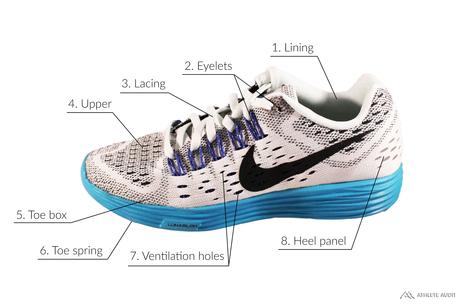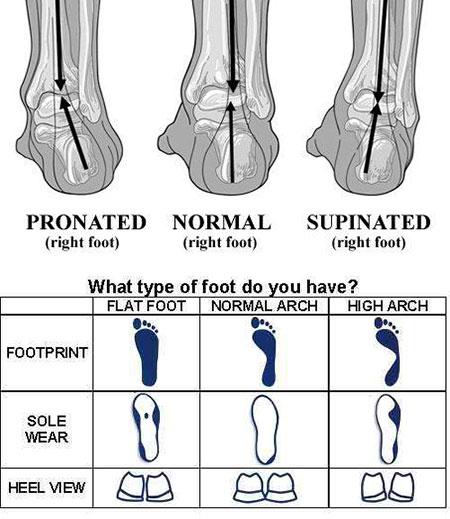In terms of body mechanics and personal preferences, no two runners are the same. As a result, there are a wide range of running shoes available to cater to every type of runner out there. But what exactly should you look for in a running shoe that will suit your needs? First and foremost, we ask that you meet a vital prerequisite and that is to “know thyself”. Doing so will allow you to find a shoe that fits your lifestyle best. Some important questions to ask yourself: what are important parts of a shoe I’ll need? What type of surface do I run on? What’s my foot type? What kind of running do I do? How should a shoe fit my foot? With all of that out in the open, let’s learn how to choose running shoes already!
How to Choose Running Shoes Infographic

How to Choose Running Shoes: In-Depth
Step 1: Discover the Anatomy



- Lining – The lining consists of a sock-like fabric that increases overall comfort
- Eyelets – Holes near the top of the shoe help to guide laces in place
- Lacing – Traditional laces are most common although you can also find velcro as well
- Upper – Lightweight and breathable, lots of running shoes feature mesh or thin synthetic leather uppers
- Toe spring – The rise or upward curve toward the front of the shoe that help the foot roll forward
- Toe box – Flexible to allow full range of motion of a gait
- Ventilation holes – Helps to make the shoe breathable so that moisture doesn’t build up
- Heel panel – The section of the shoe that covers the heel
- Collar – A padded collar improves comfort and ankle support
- Tongue – Fairly thin and breathable, also very comfortable
- Toe cap – Improves the durability of a running shoe and helps when lifting off the toe
- Insole – The footbed of a shoe. Very comfortable and offers orthotic support
- Last – Beneath the insole lies the last, which determines the overall shape of the shoe
- Shank – Some running shoes may incorporate a shank, which sits between the insole and midsole and provides rigidity for the sole
- Midsole – Essentially the main cushioning of a running shoe (usually foam-based). Thicker in the arch and heel area for more comfort and shock absorption
- Heel-to-toe drop – Refers to the difference between the height of the heel to the height of the toe, which affects how your foot strikes the ground
- Heel counter – A rigid plastic insert behind the heel that provides structural support for the heel area
- Outsole – Refers to the rubber bottom of a running shoe. The outsole pattern can differ between road and trail runners
- Shape – Shaped by the last and determines how a shoe will fit in the heel, arch, and forefoot
- Tread – A unique tread pattern provides traction on a variety of surfaces
- Flex grooves – Helps to increase the flexibility of a shoe for full range of motion
Step 2: Choose the Right Shoe Type
Road running shoes – Road running shoes are made specifically for those who like to jog on pavement or asphalt. Thus, this type of running shoe meets the needs of most runners. So if you’re not quite sure what kind of shoe you need, odds are, it’ll be some of these.
Road shoes are built lightweight and flexible, with lots of cushioning and an extremely airy upper to keep your feet cool even in sweltering weather. Road running shoes often have a higher heel-to-toe drop, and the outsole features low-profile lugs so you can always remain nimble.
Trail – Trail running shoes, on the other hand, are made for those who enjoy running on outdoor trails or soft, muddy ground. These types of shoes are only meant to be used on rugged terrain, using them on roads will be overkill.
With often a wider outsole for stability and aggressive tread, trail running shoes help keep you solid and secure on uneven terrain. They feature more support and protection, with thicker uppers and toe caps included for improved durability.

Step 3: What is Your Foot Type?

To find your foot type, start by looking at your previous running shoes (or athletic shoes for that matter) and find where they’ve worn down the most. Shoes with a lot of wear on the inside of the soles or around the ball of your foot means you have a foot that regularly overpronates. If the outside of the heel or toes show wear, you have a supinated foot. Lastly, if there are even amounts of wear throughout your shoe, then your foot type is neutral, which is ideal.
However, if you want a more accurate measurement, you can always perform a wet test. Simply wet the bottom of your foot with water and place it on a visible surface such as a brown paper bag or concrete. Now, check the imprint and see what it matches on the chart. If your arch is very thin, your feet are supinated. If the arch is as large as the rest of your foot, your feet overpronate. And if your arch is not too thin or large, then your feet are neutral.
Know Your Foot Type
Neutral -A neutral arch is the ideal foot type, and allows you to wear almost any shoe you want, given that it’s comfortable for you. Therefore, comfort should be your biggest priority if you have neutral feet, although neutral cushioned shoes help to promote natural foot motion.
Supinated – Having a high arch means your ankles are naturally inclined outwards. This means that there isn’t a lot of inward stability so you’ll want to focus on cushioning and flexibility in a pair of running shoes. Neutral cushioned shoes work well with this type of foot.
Pronated (Overpronation) – A pronated foot means a low arch, and that means your ankles have the tendency to roll inwards, or overpronate. This can lead to injury more often than the other foot types, so you’ll want running shoes that have lots of stability and lateral support. Motion control shoes are also a good choice for those who severely overpronate. You should also consider adding your own insoles or orthotics for the support you need around your arches.
Step 4: Consider Your Running
What Do You Prefer in a Shoe?
- I want a barefoot feel or to strengthen my feet – Absolute minimum cushioning
- I race competitively, want more feel, or want to strengthen my feet – Very minimal cushioning
- I run daily, do tempo running, or have ran for a number of years – Moderate cushioning
- I run daily or participate in casual races – Moderate to high cushioning
- I am older, new to running, or participate in half or full marathons – Max cushioning
How Much Do You Run?
- Less than 10 miles/week – Prioritize support/stability and look for high density midsoles and low to moderate cushioning
- Around 10-30 miles/week – Prioritize responsiveness and look for moderate cushioning, lightweight, and flexibility
- More than 30 miles/week – Prioritize comfort and look for high cushioning and a lightweight build
*** NOTE: Our suggestions are not in any way definitive and are only meant as starting guidelines. Your individual preferences for what you want in a shoe counts for more than what any guide on how to choose running shoes can recommend you. That being said, you can always look into having multiple pairs of shoes for different types of running you might do ***
Step 5: Find the Right Fit
Signs of a Perfect Fit
- Around 1/8 to 1/4″ of space in the toe with a snug fitting forefoot and heel that doesn’t lift
- Fits the width and volume of your foot. Note that width and volume do not mean the same thing
- There should be absolutely no pain, discomfort, or chafing of the foot
- There should be adequate flexibility and cushioning for your feet
- Even pressure and comfort on the arches when standing on the ball of your foot
- Toes should not be able to touch the front of the shoes while running
Tips For Fitting Running Shoes
- Try running in a pair of shoes to ensure that they are comfortable no matter what
- Wear socks you intend to use running while fitting shoes for an accurate fit
- Consider adding your own insoles or orthotics for more comfort or a better fit
- Try shoes on in-store and in the afternoon, as feet tend to swell throughout the day
- Learn lacing techniques if you’d like to get a snugger fit in the midfoot or heel area
- Try multiple sizes of the same shoe to find the most comfortable pair for you

